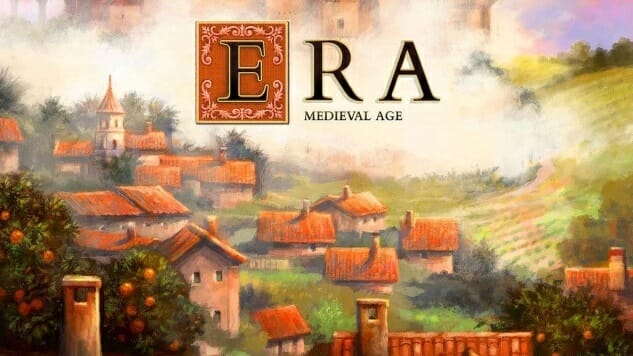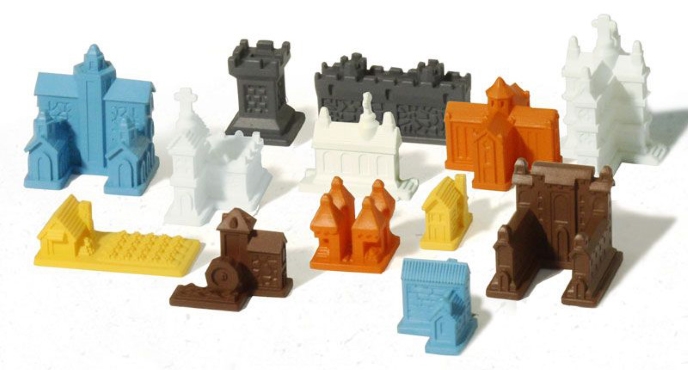
If you know game designer Matt Leacock’s name, it’s probably because of his acclaimed batch of cooperative games headed by Pandemic (and now Pandemic Legacy), a series of five core games with many brand extensions that all rely on the same core set of rules for players. He’s more responsible for the popularity of cooperative tabletop games today than anyone else.
Leacock has had one hit in the competitive gaming space, however, in Roll Through the Ages: The Bronze Age, a roll-and-write game from 2008 that borrowed the theme of the complex strategy game Through the Ages but introduced entirely new mechanics. Players would roll dice to gain resources, rerolling one or two more times but setting aside dice with hazard symbols, then using resources to build ‘developments’ or ‘monuments’ which they’d simply mark off on their own scoresheets. Where Through the Ages is a solid two hours just to play, not counting the extensive setup, Roll Through the Ages: The Bronze Age plays in well under an hour and there’s very little setup involved.
Leacock has now redesigned and rebranded his Roll Through the Ages game as Era: Medieval Age, a “roll and build” game that has the same dice-rolling and resource collection mechanics, but now comes with a slew of plastic buildings that players build by placing on their peg boards. This allows Leacock to introduce more ways to score (or to lose points), adding a spatial aspect to the game, introducing a light military conflict aspect, and giving players an opportunity to double their building points by walling in their cities. It will be very familiar to Roll Through the Ages players, but it’s also a new enough experience that it’s worth trying even if you loved its predecessor.
Era players start the game with four dice, five buildings, and two long wall segments, and then place their Keep (2×2) building at the center of their 14×14 peg board and place all other buildings wherever they’d like. They also may have to place one or two “scorched” tiles, rendering 3×3 areas useless, depending on the player count. In each round, all players roll all of their dice, and may choose to re-roll any of those dice up to two more times; once a die has one or more skulls appear, that die may not be re-rolled in this round. The revealed faces may grant the player food, which they must pay after each round, spending one food per die; wood, stone, or trade goods, resources used to buy buildings; culture, worth points at game-end; or swords and shields, used for the game’s one military-like aspect. Players spend resources to buy and place buildings, some of which give the player additional dice to roll (and feed), others of which give new resources each turn, and all of which are worth points at game-end. They may also buy walls to surround their buildings; once fully enclosed, the buildings are protected from some hazards, and are worth double the points at game-end.

Just before the buy phase, each player counts the skulls on all of their rolled dice to determine what disasters will hit. If you have one, two, four, six, or more skulls, you’ll face some sort of penalty, like losing resources, losing an entire unwalled building, or gaining disaster points (-1 point at game-end). One of Era’s big quirks, however, is that you can try to get to exactly three or five skulls and hit your opponents with something bad—three skulls gives each opponent a scorched area tile, five forces each to remove an unwalled building. So, in theory, if you have two skulls already, you might try to keep rolling to get a third, so that you don’t take any damage but you deal some to everyone else. After this step, you complete the buying/building process.
The final phase is the pseudo-military step, called the Extort phase, and it becomes much more powerful with more players. You may roll either swords or shields (or both) in the rolling phase, and in the Extort phase, you compare your sword counts to everyone else’s sword and shield counts. You may extort one resource from every player who has fewer swords showing than you do, as long as they don’t have more shields showing than you have swords. If the player has no resources left, or refuses to pay up (because they’re five years old?), they gain two disaster points. In a two-player game, it’s a nuisance, but not a big deal. In a four-player game, however, gaining the most swords of anyone would get you three resources from your opponents, and having the fewest swords/too few shields would mean losing three resources or up to six points. It’s a lot, and means that you’ll approach your rerolling very differently depending on player count.
The game ends when the supplies of three building types (five types in a four-player game) are exhausted, after which everyone tallies up their points. You score your buildings, doubling them if they’re enclosed by walls; gain bonus points for four of the more expensive buildings, which each have a unique scoring mechanism; gain five points if you have the most Culture; and gain 10 points if you have the largest fully walled-in area. Deduct one point for each spot you’ve moved on the disaster track and you have your final score.
Era also comes with solitaire rules that let you try to maximize your score with relatively little interference from a dummy player that rolls three dice each turn and tries to steal a resource from you. With two to four players, it’s about an hour’s experience, and runs from the low-interaction two-player environment to the higher-interaction four-player one, where buildings become scarce and you’re trying hard not to end up at the bottom of the extortion pile. I found some of the implementation a little wonky – the numbers and icons on the yellow peg boards are almost impossible to read, and the pegs used to track resources are awfully small. The buildings do look great, and it offers players a lot of options and paths to building up points; it’s a game where diversifying what you build too much can limit your scoring ceiling. It gives Roll Through the Ages a more tactile experience, and the concrete play better unites the theme and the mechanics. I also think the roll-and-build idea is a pretty solid one, even if I think it has more potential than Era shows.
Keith Law is a senior baseball writer for ESPN.com and an analyst on ESPN’s Baseball Tonight. You can read his baseball content at search.espn.go.com/keith-law and his personal blog the dish, covering games, literature, and more, at meadowparty.com/blog.